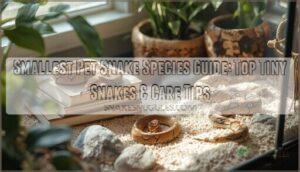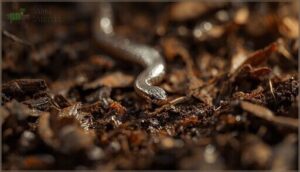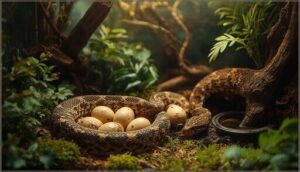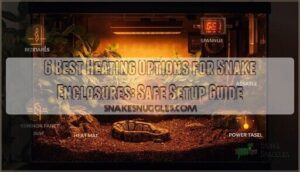This site is supported by our readers. We may earn a commission, at no cost to you, if you purchase through links.

You won’t find many pets that thrive in the same footprint as a shoebox, but several snake species do exactly that. A ringneck snake needs roughly the same floor space as three stacked paperback novels, while a Kenyan sand boa settles comfortably into an enclosure smaller than most cat carriers.
These compact reptiles offer something rare in the pet world: genuine low-maintenance companionship without sacrificing the fascination of keeping an exotic animal. Their modest size translates to simpler habitat setups, lower feeding costs, and handling sessions that won’t test your arm strength or nerves.
Whether you’re working with limited apartment space or simply want a reptile that won’t demand a dedicated room, small snakes pack considerable variety into their diminutive frames.
Table Of Contents
- Key Takeaways
- Benefits of Choosing Small Pet Snakes
- Top Smallest Pet Snake Species
- Popular Beginner-Friendly Small Snakes
- Key Characteristics of Small Snake Species
- Setting Up The Ideal Snake Habitat
- Feeding and Nutrition for Small Snakes
- Health, Maintenance, and Safety Tips
- Frequently Asked Questions (FAQs)
- What is the smallest snake you can have as a pet?
- What snake can live in a 20 gallon tank?
- What is the friendliest snake as a pet?
- What pet snake lives the shortest?
- Do small snakes require veterinary checkups regularly?
- Can small snakes live together peacefully?
- What permits are needed for owning snakes?
- How much do small pet snakes cost?
- Are small pet snakes legal in all states?
- Can small snakes live together in one tank?
- Conclusion
Key Takeaways
- Small pet snakes like ringneck snakes and Kenyan sand boas thrive in compact enclosures, making them ideal for limited spaces.
- Beginner-friendly species such as corn snakes, rosy boas, and ball pythons are known for their docile temperaments and straightforward care requirements.
- Feeding and habitat maintenance for small snakes are manageable, with most species needing weekly feedings and simple cleaning routines.
- Lifespans for small snakes can range from a single year to over 30 years, so owning one is a long-term commitment that requires consistent care.
Benefits of Choosing Small Pet Snakes
Small pet snakes offer real advantages that make them easier to keep than their larger cousins. You’ll need less space, they’re simpler to handle, and their care requirements won’t overwhelm your schedule or budget.
Let’s look at the key benefits that make these compact reptiles such practical pets.
Space and Enclosure Requirements
One of the biggest perks of small snakes is how little space they need. Most species thrive in compact setups that fit easily in your home, unlike their larger cousins.
- Ringneck snakes can live comfortably in a 10-15 gallon enclosure, roughly 20-24 inches long
- Kenyan Sand Boas need just 24 by 12 by 12 inches, with substrate depth for burrowing
- Children’s pythons do well in 36 by 18 by 18 inch reptile enclosures
Managing snake enclosures becomes simpler when you’re working with smaller dimensions, leaving more room for habitat complexity and thermoregulation needs without overwhelming your space. They also need low humidity levels.
Ease of Handling and Temperament
Beyond compact enclosures, small snakes shine in terms of handling and temperament. Species like corn snakes and rosy boas rarely bite—over 90% of owners report stress-free interactions after brief acclimation. Their defensive behaviors lean toward harmless bluffing rather than aggression, making them excellent for beginner suitability and child safety.
Mini corn snakes, for example, are known for their calm demeanor, making them suitable for reptile enthusiasts. You’ll spot stress indicators like hiding or flattening early, and safe handling becomes second nature with gentle, consistent practice.
Lifespan and Commitment Level
Handling may seem straightforward, but understanding snake lifespans reveals the true scope of your commitment. Small pet snakes like ball pythons live 20–30 years, while corn snakes reach 15–20 years—outlasting many dogs and cats.
Small pet snakes demand decades of care—ball pythons live 20–30 years, often outlasting dogs and cats
Early mortality sits under 4% with proper care, yet long-term care means:
- Decades of weekly feedings and habitat maintenance
- Enclosure upgrades as juveniles mature over 2–4 years
- Owner experience spanning multiple life chapters
That’s a commitment comparison few first-timers anticipate.
Top Smallest Pet Snake Species
If you’re looking for a snake that stays truly compact, you’re in luck. Some species top out at just a few inches, while others stay under three feet their entire lives.
Here’s a look at five of the smallest pet snakes you can actually keep at home.
Barbados Threadsnake
The Barbados threadsnake holds the record as the world’s smallest snake species, discovered in 2008 in Barbados. At just under 4 inches long and weighing only 0.6 grams, it’s as thin as a spaghetti noodle.
Unfortunately, you won’t find this tiny marvel in captivity—it’s restricted to a few square kilometers of secondary forest and isn’t available as a pet.
Brahminy Blind Snake
If you’re curious about one of the smallest pet snakes around, Brahminy blind snakes reach just 2.4–6.5 inches in captivity. These small snake species are remarkably hardy and thrive with minimal care—just 20 ant pupae or termites every couple of weeks.
They’re known for parthenogenesis reproduction, meaning females reproduce without males, which explains their impressive colonization ability. With proper care, you can expect a captive lifespan approaching one year.
Ringneck Snake
Ringneck snakes grow 10–15 inches on average, though some reach up to 27.7 inches. They’re classified as harmlessly venomous, but their venom potency poses zero threat to you due to their tiny mouths. You’ll notice sexual dimorphism—females grow larger than males.
These small pet snakes have a secure conservation status and wide geographic distribution, making captive care straightforward for beginners seeking nonvenomous options.
Kenyan Sand Boa
Kenyan Sand Boas hatch at 6–8 inches and mature to 24–36 inches, making them ideal small pet snake species for beginners. Males stay slightly smaller than females, and with proper snake care, these small snakes can live over 15 years.
You’ll appreciate their even temperament and burrowing behavior—they spend much of their time beneath sandy substrate. Their moderate enclosure enrichment needs and morph variations make handling techniques straightforward for novice keepers.
African Egg-Eating Snake
The African Egg-Eating snake thrives on an unusual diet—exclusively quail eggs—making it perfect for beginner reptile enthusiasts who want a small snake species with minimal feeding hassle. Adults reach just 1–3 feet, requiring simple snake care:
- Enclosure size: 36 x 18 x 12 inches
- Temperature control: 85–90°F daytime, 75°F nighttime
- Humidity levels: maintain 50–60%
Their unique snake diet and modest habitat needs simplify ownership considerably.
Popular Beginner-Friendly Small Snakes
If you’re just getting started with snakes, you’ll want a species that won’t test your patience or your nerves. Some small snakes are naturally calm, forgiving of minor care mistakes, and easy to handle—making them perfect for first-time owners.
Here are four beginner-friendly options that consistently prove themselves as reliable, low-stress companions.
Rosy Boa
If you’re looking for a small pet snake that won’t test your patience, the Rosy Boa is an excellent choice for beginner snake care. These small snakes generally measure 24 to 36 inches, making them manageable without sacrificing personality.
You’ll find various Rosy Boa morphs to suit your aesthetic preferences, and their docile temperament makes handling techniques straightforward.
With proper enclosure enrichment and care, your Rosy Boa can thrive for 20 to 30 years in captivity.
Western Hognose Snake
The Western Hognose stands out with its upturned snout and dramatic bluff behavior, flattening its neck and hissing when startled.
You’ll appreciate this small snake’s manageable size of 14 to 22 inches and docile temperament once handled regularly. Beginner snake care is straightforward, though feeding issues can occasionally arise.
Captive breeding has produced stunning morphs, and with proper veterinary care, you’ll enjoy years together.
Ball Python
Ball pythons remain among the most beginner-friendly snakes despite reaching 3 to 5 feet as adults. You’ll find their calm, docile temperament ideal for learning snake care, though you must commit to 20 to 30 years of pet ownership.
- Provide a 40-gallon enclosure with 80–82°F ambient temperature
- Feed appropriately sized rodents every 7–14 days
- Maintain 50–60% humidity, increasing during shedding
- Monitor for respiratory infections and feeding refusal
Corn Snake
Corn snakes offer even more variety than ball pythons, with over 50 color morphs available through selective breeding. Their slender build—usually 2 to 5 feet—and straightforward care needs make them an appealing choice.
Feeding requirements are manageable: every 7–14 days for juveniles and every 14–21 days for adults. Their gentle handling techniques and minimal enclosure enrichment further contribute to their ease of care.
Corn snakes are ideal beginner snakes for first-time reptile keepers, thanks to their low-maintenance nature and docile temperament.
Key Characteristics of Small Snake Species
Small snake species share a few key traits that make them stand out from their larger cousins. Understanding these characteristics helps you choose the right snake for your home and lifestyle.
Let’s break down the size ranges, color patterns, and typical behaviors you can expect from these compact reptiles.
Average Size and Weight
Small snake species display striking size variations, from the Barbados threadsnake at just 4 inches and 0.6 grams to the African egg-eating snake reaching 39 inches. Weight factors range considerably, with smaller species generally weighing under 2 grams compared to larger varieties approaching 500 grams.
You’ll find that most beginner-friendly options like Kenyan sand boas grow 15 to 32 inches, while ringneck snakes stay under 20 centimeters.
Coloration and Morphs
You’ll discover fascinating pattern variations across species, from ringneck snakes displaying olive to smoky black coloration with distinctive yellow, red, or orange neck bands, to rosy boas showcasing locale differences with three longitudinal stripes.
Corn snakes offer over 800 morphs derived from genetic mutations, including rare scaleless variants valued at $500–$700, while Kenyan sand boas present six recognized color phases, including striking paradox morphs.
Temperament and Behavior
When you’re evaluating snake temperament and behavior, handling tolerance varies widely across species. A 2021 survey found that 61% of captive snakes displayed calm temperaments during routine interaction, yet stress behaviors—such as boundary interaction and escape attempts—appeared in over half of observed animals.
Proper enrichment impacts these outcomes greatly: snakes in complex habitats show lower stress hormones and fewer defensive displays, making owner interaction smoother and more predictable overall.
Setting Up The Ideal Snake Habitat
Creating a proper habitat is one of the most important steps in keeping your snake healthy and stress-free. The right setup depends on your snake’s specific needs, from the size of the enclosure to the temperature gradient it requires.
Let’s look at the key elements you’ll need to think about when building your snake’s home.
Enclosure Types and Sizing
Choosing between rack systems and glass terrariums depends on your snake’s spatial preference and stretching behaviors. Research shows snakes housed in enclosures longer than their body length display more activity and full-body elongation.
Floor space matters more than terrarium height for most small species. A proper snake enclosure setup prioritizes horizontal room—your snake habitat requirements should allow complete stretches, not just adequate volume.
Heating, Lighting, and Humidity
Once you’ve nailed the floor plan, your snake habitat requirements expand to climate control—certainly the most significant aspect of reptile care. Your snake enclosure setup needs precise thermal gradients, lighting cycles, and humidity levels to prevent shedding issues and support healthy behavior.
Essential monitoring tech for snake care requirements:
- Digital probe thermometers at both cool (75°F) and warm (90°F) zones
- Multiple hygrometers tracking 60–80% humidity across the temperature gradient
- Quality thermostats preventing dangerous overheating
- Full-spectrum LEDs (6000–7000K) on 12-hour cycles
- UVB output meters ensuring safe 2.0–3.0 UVI levels
Substrate and Hiding Spots
Your substrate choice directly impacts burrowing depth and stress levels in small snakes. Natural substrates like aspen shavings (3–6 inches deep) support digging behavior and maintain enclosure hygiene, while coconut fiber holds moisture effectively.
Shelter selection matters too—provide multiple habitat accessories sized to fit your snake snugly, creating secure refuges that reduce physiological stress.
Spot-clean waste promptly, and replace substrate when odor appears, balancing hygiene practices with stable scent cues your snake recognizes.
Feeding and Nutrition for Small Snakes
Feeding your small snake properly is one of the most important parts of keeping it healthy and thriving. Different species have specific dietary needs, and getting the prey size and feeding schedule right can prevent digestive issues and stress.
Let’s look at what your snake should eat, how often to feed it, and the safest ways to offer food.
Typical Diets by Species
Your snake’s diet depends entirely on its species. Rosy boas, ball pythons, and corn snakes thrive on mice, while Kenyan sand boas prefer small rodents every 10 to 14 days.
Ringneck snakes eat earthworms and slugs, and garter snakes consume worms, amphibians, and small fish.
African egg-eating snakes need only eggs, specifically from doves or pigeons, making their nutritional needs quite unique among captive species.
Feeding Frequency and Prey Size
Your snake’s feeding schedule depends on its age, size, and species. Juveniles under 50g need prey every 4–7 days, while adults eat every 1–4 weeks.
Prey size selection matters—offer food matching your snake’s widest body part to prevent regurgitation. Smaller snakes require pinkies weighing 0.5–3g, while larger ones handle fuzzies up to 12g.
Veterinary feeding advice ensures you’re meeting your snake’s individual nutritional needs safely.
Safe Feeding Practices
Beyond timing and prey size, how you feed your snake directly impacts its health and your safety. Snake feeding done right minimizes foodborne illness and stress for your pet.
Follow these feeding environment guidelines:
- Always use feeding tools like tongs—they reduce accidental bites by over 80%
- Choose frozen prey over live options to prevent injury from defensive rodents
- Feed in a separate container to reduce territorial aggression and substrate ingestion
- Wait 48 hours before post-feeding handling to avoid stress-induced regurgitation
Wash your hands before and after every feeding session. This simple habit cuts salmonella transmission risk considerably, protecting both you and your snake from preventable health complications tied to snake diet and nutrition practices.
Health, Maintenance, and Safety Tips
Keeping your small snake healthy means watching for warning signs, staying on top of habitat upkeep, and handling your pet safely. Regular maintenance and quick action when something seems off can prevent most problems before they become serious.
Let’s look at the essential health checks, cleaning routines, and safety practices every small snake owner should know.
Common Health Issues
Even healthy-looking snakes face several reptile health challenges you should watch for. Respiratory infections are common, especially when humidity or temperature isn’t right. Parasitic infections can affect nearly half of captive snakes. Salmonella carriage is another snake health concern, with over half of pet snakes carrying it.
Thermal injuries from unshielded heat sources and shedding disorders from low humidity round out the major signs of illness requiring preventative care.
Regular Cleaning and Habitat Checks
Preventing illness starts with consistent pet snake care and maintenance. Spot cleaning waste daily keeps bacteria at bay, while deep cleans every month disinfect the entire enclosure. Substrate maintenance varies by bedding type—aspen generally needs monthly swaps. However, excessive cleaning stresses your snake, so balance is key.
Daily habitat checks let you catch problems early, from faulty equipment to mold, directly protecting snake health through smart detection protocols.
Safe Handling and Owner Precautions
Handling small snakes safely protects you and your pet. Wash hands immediately after contact—studies show over half of pet snakes carry Salmonella, which hits kids hardest.
Three core snake handling techniques prevent trouble:
- Support the full body to avoid stress and defensive strikes
- Use feeding tongs during meals so hands don’t smell like prey
- Secure enclosure locks since these escape artists squeeze through tiny gaps
Watch body language before picking up your snake—flattened postures signal defensiveness.
Frequently Asked Questions (FAQs)
What is the smallest snake you can have as a pet?
The smallest snake you can keep as a pet is the Brahminy blind snake, which reaches just 9 to 9 inches. However, legality considerations and ethical concerns vary by region.
What snake can live in a 20 gallon tank?
You might think a 20-gallon tank suits any small snake species permanently, but that’s only half true. Juveniles like corn snakes fit temporarily, while adult Kenyan sand boas thrive long-term in this enclosure size.
What is the friendliest snake as a pet?
Ball pythons consistently rank as the friendliest snake breed, with documented bite incidents under 2% during routine handling. Corn snakes and rosy boas also show remarkably docile temperament, making them ideal beginner-friendly pets.
What pet snake lives the shortest?
If you’re curious about short-lived pet snakes, garter snakes stand out. Garter snake lifespan is just 2–4 years in the wild, while ringneck snake longevity rarely exceeds six years in captivity, mainly due to predation impact and snake health concerns.
Do small snakes require veterinary checkups regularly?
Even the tiniest snakes deserve exam frequency fit for royalty—annual checkups with a reptile vet are key.
Preventative care boosts early detection of common ailments, lets you catch subtle signs of illness, and husbandry impact promotes lifelong snake health and maintenance.
Can small snakes live together peacefully?
Small snakes rarely live together peacefully. Cohabitation risks—like stress, aggression, and injury—are high, except for a few social species. Veterinary recommendations favor solitary housing.
Proper enclosure design and careful species compatibility are essential for safe group setups.
What permits are needed for owning snakes?
Ever wonder what legal rules about snakes you need to follow? Federal regulations, state permits, and local ordinances all play a part in reptile licensing.
Welfare provisions and penalties guarantee responsible pet ownership, so check requirements before bringing home a snake.
How much do small pet snakes cost?
Species price ranges for small pet snakes run $20–$250, with morph cost factors pushing prices higher.
Setup expense breakdown starts at $150, while feeding cost analysis shows $5–$15 monthly.
Long-term ownership costs depend on care and health needs.
Are small pet snakes legal in all states?
State legality for small pet snakes varies widely, with permit requirements and species restrictions often changing due to legislative updates.
Legal regulations differ by region, so always check local legal rules about snakes before snake ownership to avoid enforcement penalties.
Can small snakes live together in one tank?
Picture two small snakes weaving through one enclosure—sounds cozy, right? In reality, cohabitation risks outweigh the benefits.
Species compatibility is rare, tank size matters, and feeding behavior often triggers stress indicators and aggression among most small snake species.
Conclusion
As the saying goes, “Good things come in small packages.” Small snakes prove this true, offering manageable care and engaging behaviors in surprisingly compact habitats.
By using this smallest pet snake species guide, you’re equipped to select a species that fits your space, lifestyle, and comfort level. Each snake’s unique needs and personality makes your experience stay rewarding and safe.
With careful attention, even the tiniest reptile can become a fascinating companion for years to come.
- https://onurbicycle.wordpress.com/2020/05/07/smallest-pet-snakes/
- https://a-z-animals.com/animals/snake/snake-facts/pet-snakes-that-stay-small/
- https://petadvocacy.org/wp-content/uploads/2022/01/Snakes-Care-Sheet.pdf
- https://americanpetproducts.org/blog/scaling-up-bigger-tanks-snake-comebacks-and-data-insights
- https://paradepets.com/pet-news/best-small-animal-breeds-for-first-time-pet-owners-according-to-a-vet
















